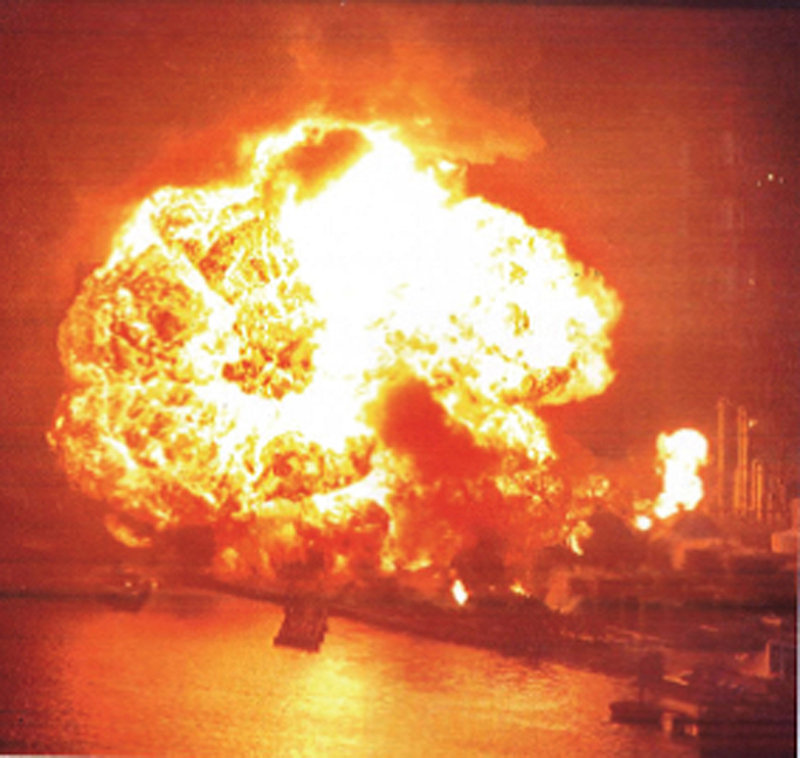References
Asahi Shibun, 2011. Tohoku tsunami washed arsenic ashore, September 3, 2011. http://ajw.asahi.com/article/0311disaster/quake_tsunami/AJ2011100713655
Cosmo Oil, 2011. Overview of the fires and explosion at Chiba refinery, the cause of the accident and the action plan to prevent recurrence, Press Release August 2, 2011. http://www.cosmo-oil.co.jp/eng/press/110802/index.html
Cruz, A.M., 2003. Joint natural and technological disasters: assessment of natural disaster impact on industrial facilities in highly urbanized areas. Dissertation. UMI Number: 3116886, 204 pp.
Cruz AM, Krausmann E. Damage to offshore oil and gas facilities following Hurricanes Katrina and Rita: an overview. J. Loss Prev. Process Ind. 2008;21(6):620.
Cruz AM, Krausmann E. Hazardous-materials releases from offshore oil and gas facilities and emergency response following hurricanes Katrina and Rita. J. Loss Prev. Process Ind. 2009;22(1):59.
Cruz AM, Steinberg LJ. Industry preparedness for earthquakes and earthquake-triggered hazmat accidents during the kocaeli earthquake in 1999: a survey. Earthquake Spectra. 2005;21(2):285.
EERI, 1999. The Izmit (Kocaeli), Turkey earthquake of August 17, 1999. Special Earthquake report, Earthquake Engineering Research Institute, Oakland, CA.
Emiroğlu C, Koşar L, Karadağ K, Abbasoğlu S, Başçıl HS. AKSA reality. Turk. J. Occup. Health Saf. 2000;3:12.
Girgin S. The Natech events during the 17 August 1999 Kocaeli earthquake: aftermath and lessons learned. Nat. Hazards Earth Syst. Sci. 2011;11:1129.
Guidry, R.J., 2006. From the incident command center oil spills from hurricanes Katrina and Rita. Proceedings of the Environment Canada Arctic and Marine Oil Spill Program Technical Seminar (AMOP), vol. 2: 989, Vancouver, BC, Canada, June 6–8, 2006.
HSE The Explosion and Fires at the Texaco Refinery, Milford Haven, 24 July 1994. United Kingdom: Health and Safety Executive; 1997.
JX Nippon Mining and Metals, 2012. Casualties caused by the Great East Japan earthquake and responses at the Oya Mine. http://www.nmm.jx-group.co.jp/english/sustainability/environmental_activities/abolition.html
Kilic A. Tüpraş Yangını (TUPRAS Fire). Istanbul: Istanbul Technical University; 1999: .
Kilic SA, Sozen MA. Evaluation of effect of August 17, 1999, Marmara Earthquake on two tall reinforced concrete chimneys. Struct. J. 2003;100(3):357.
Knabb, R.D., Rhome, J.R., Brown, D.P., 2006a. Tropical Cyclone Report, Hurricane Katrina, August 23–30, 2005. National Hurricane Center, United States. http://www.nhc.noaa.gov/data/tcr/AL122005_Katrina.pdf
Knabb, R.D., Brown, D.P., Rhome, J.R., 2006b. Tropical Cyclone Report, Hurricane Rita September 18–26, 2005, National Hurricane Center, United States. http://www.nhc.noaa.gov/data/tcr/AL182005_Rita.pdf
Koehler, A.N., 2007. Acute releases of hazardous substances related to Hurricanes Katrina and Rita. Louisiana Hazardous Substances Emergency Events Surveillance (LaHSEES) System, Louisiana Department of Health and Hospitals, Office of Public Health, Section of Environmental Epidemiology and Toxicology.
Krausmann E, Cruz AM. Impact of the 11 March 2011, Great East Japan earthquake and tsunami on the chemical industry. Nat. Hazards. 2013;67:811.
Leahy S. Years Before Katrina’s Environmental Costs can be Measured. Rome: Inter Press Service; 2005.
Marsh The 100 Largest Losses 1972–2001—Large Property Damage Losses in the Hydrocarbon-Chemical Industries. twentieth ed. New York: Marsh Risk Consulting; 2003.
MMS, 2006. Impact assessment of offshore facilities from Hurricanes Katrina and Rita, News Release 3418, January 19, US Minerals Management Service.
Nishi, H., 2012. Damage on hazardous materials facilities, In: Proceedings of the International Symposium on Engineering Lessons Learned from the 2011 Great East Japan Earthquake, Tokyo, Japan, March 1–4, 2012.
NTSB Evaluation of Pipelines Failures During Flooding and of Spill Response Actions, San Jacinto River Near Houston, Texas, October 1994, Pipeline Special Investigation Report. Washington, DC: National Transportation Safety Board; 1996.
Pardue JH, Moe WM, McInnis D, Thibodeaux LJ, Valsaraj KT, Maciasz E, van Heerden I, Korevec N, Yuan QZ. Chemical and microbiological parameters in New Orleans floodwater following Hurricane Katrina. Environ. Sci. Technol. 2005;39(22):8591.
Pine JC. Hurricane Katrina and oil spills: impact on coastal and ocean environments. Oceanography. 2006;19(2):37.
Sengul H, Santella N, Steinberg LJ, Cruz AM. Analysis of hazardous material releases due to natural hazards in the United States. Disasters. 2012;36(4):723.
Şenocaklı, M., 1999. İnsanları enkaz altında canlı bırakıp kaçtık! (We escaped leaving people behind under the debris), Vatan, July 10 (in Turkish).
Simpson RH, Riehl H. The Hurricane and its Impact. Baton Rouge: Louisiana State University Press; 1981.
Steinberg LJ, Cruz AM. When natural and technological disasters collide: lessons from the Turkey earthquake of August 17, 1999. Nat. Hazards Rev. 2004;5(3):121.
Tang, A.K., 2000. Izmit (Kocaeli), Turkey, Earthquake of August 17, 1999, including Duzce Earthquake of November 12, 1999. Lifeline Performance, Technical Council on Lifeline Earthquake Engineering (TCLEE), Monograph No. 17, ASCE, Virginia.
Tsunami Research Group Izmit Bay Tsunami Survey, August 22–26, 1999, Tsunami Research Group. Los Angeles: University of Southern California; 1999.
Türk, E., 1999. Aksa’nın zehiri bölgedeki balıkları öldürdü (Poison of AKSA killed fish in the area), Milliyet, September 9, p. 11 (in Turkish).
Wada, Y., Wakakura, M., 2011. Japan Report, 21st Meeting of the OECD Working Group on Chemical Accidents, October 5–7, 2011, Paris, France.











